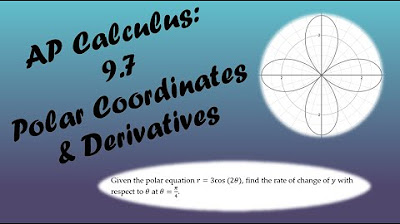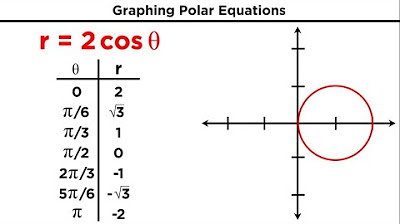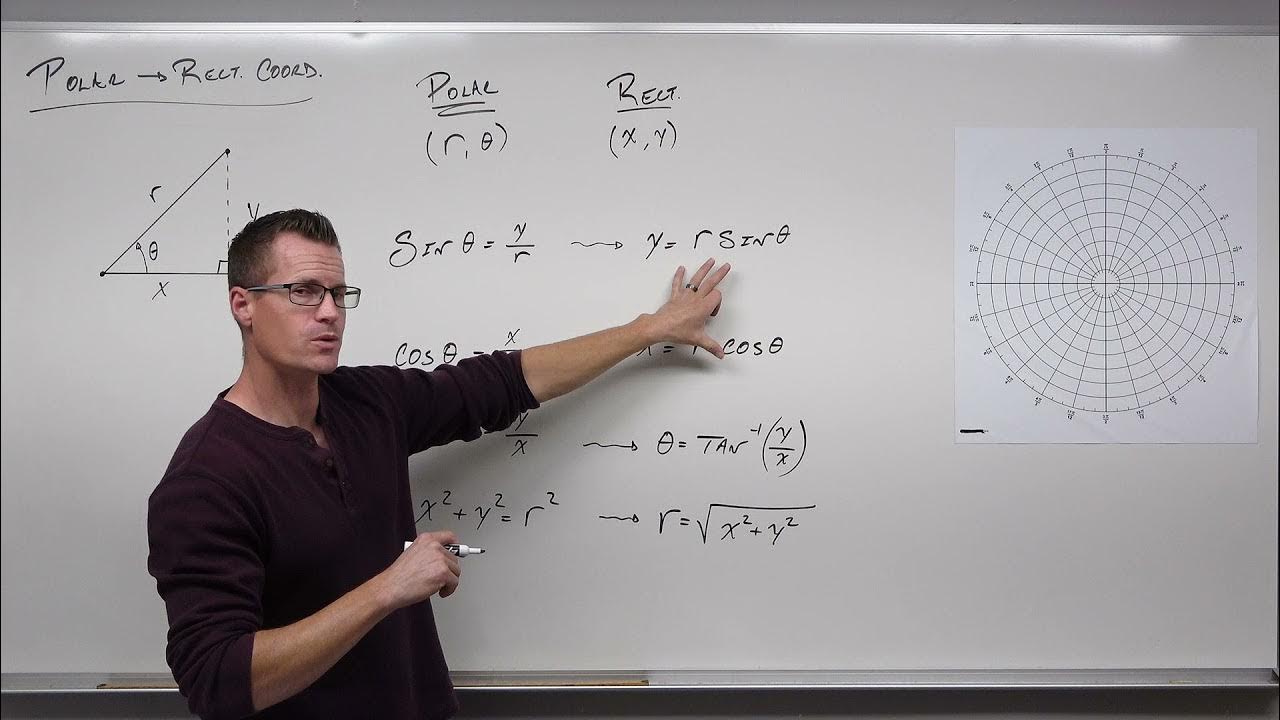Polar Curves
TLDRThis video offers an introduction to polar coordinates, contrasting them with rectangular coordinates and explaining their applications. It covers the conversion between polar (r, θ) and rectangular (x, y) coordinates using trigonometric relationships. The presenter demonstrates how to graph basic polar curves, such as circles and rose curves, and discusses the calculus of polar curves, including finding slopes and tangents. Examples of polar equations are provided, along with their graphical representations and applications in solving problems related to slopes and distances in polar coordinates.
Takeaways
- 📚 The video introduces polar coordinates, explaining the difference between rectangular and polar coordinates and their applications.
- 📐 Polar coordinates are represented by r (distance from the origin) and θ (angle from the positive x-axis), contrasting with rectangular coordinates (x, y).
- 🔍 To convert rectangular coordinates to polar, use the formulas r = sqrt(x^2 + y^2) and θ = arctan(y/x), though finding θ can be more complex than for standard angles.
- 📉 The video provides examples of converting specific points from rectangular to polar coordinates, demonstrating the process and the importance of considering the correct quadrant for θ.
- 📈 The relationship between x, y, r, and θ is explored, with formulas x = r cos(θ) and y = r sin(θ) being key for converting between coordinate systems.
- 🌐 The video discusses the graphing of polar curves, explaining that r = a represents a circle with radius a, and r = cos(θ) or r = sin(θ) traces out a semicircle.
- 📊 The concept of lines in polar coordinates is introduced, with θ = constant representing lines that extend infinitely in the direction of θ.
- 🌹 The video demonstrates how to graph more complex polar curves, such as r = sin(3θ) and r = cos(4θ), which create rose curves with multiple petals.
- 🔢 The video covers basic calculus in polar coordinates, focusing on finding slopes and tangent lines, using derivatives dy/dx = y'/x' where y = r sin(θ) and x = r cos(θ).
- 📍 The video concludes with practical problems, such as finding the maximum distance from the origin for a given polar curve and determining the value of θ for a point with a specific y-coordinate.
Q & A
What is the main topic of the video?
-The main topic of the video is polar coordinates and polar curves, explaining the concepts and how they relate to rectangular coordinates.
What are the two main components of a polar coordinate system?
-The two main components of a polar coordinate system are the radius (r), which measures the distance from the origin, and the angle (theta), which indicates the direction from the origin.
How can you convert rectangular coordinates (x, y) to polar coordinates (r, theta)?
-To convert rectangular coordinates to polar coordinates, you can use the formulas r = √(x² + y²) and theta = arctan(y/x). However, note that theta can vary depending on the quadrant.
What is the relationship between x and r in polar coordinates?
-In polar coordinates, x is related to r by the formula x = r * cos(theta).
What is the relationship between y and r in polar coordinates?
-In polar coordinates, y is related to r by the formula y = r * sin(theta).
How does the video describe the usefulness of polar coordinates in real-life scenarios?
-The video uses the analogy of giving directions to a gas station. Rectangular coordinates are like giving specific street addresses, while polar coordinates are like describing the distance and direction from a known point.
What are some basic polar equations that the video discusses?
-The video discusses basic polar equations such as r = 2, r = cos(theta), r = sin(theta), and r = theta, which represent circles and lines in polar coordinates.
How does the video explain the graph of r = 2 sin(3θ)?
-The graph of r = 2 sin(3θ) is described as a rose curve with three petals, traced out over the interval from 0 to π.
What is the significance of the theta step in graphing polar equations on a calculator?
-The theta step is important because it determines the resolution of the graph. A smaller step size, like π/24, can provide a more detailed graph, especially for complex polar equations.
How does the video approach finding the slope of a polar curve at a specific point?
-The video explains that the slope of a polar curve at a specific point is found by calculating dy/dx = y'/x', where y = r * sin(theta) and x = r * cos(theta), and then evaluating these derivatives at the given theta value.
What is the method used in the video to find the largest distance from the origin in a polar curve?
-The video uses the method of finding the maximum value of the absolute value of r by setting the derivative of r with respect to theta equal to zero and solving for theta, then evaluating r at those points.
How does the video solve for the value of theta that corresponds to a point on a polar curve with a specific y-coordinate?
-The video sets up the equation r * sin(theta) = y, where y is the given y-coordinate, and solves for theta by setting the equation equal to zero and using a calculator to find the roots.
Outlines
📚 Introduction to Polar Coordinates
The script begins with an introduction to polar coordinates, contrasting them with the more familiar rectangular coordinates. The instructor explains that polar coordinates are based on the distance 'r' from the origin and the angle 'theta' from the positive x-axis. An example is given to illustrate the conversion from rectangular coordinates (x=3, y=4) to polar coordinates using trigonometry to find 'theta'. The importance of understanding both coordinate systems is emphasized, as each has its own practical applications, such as giving directions versus exact addresses.
📐 Formulas and Examples for Polar Coordinates
This section delves into the mathematical relationships between rectangular (x, y) and polar (r, theta) coordinates. The formulas x = r * cos(theta) and y = r * sin(theta) are introduced to convert from polar to rectangular coordinates. Conversely, r is found using the Pythagorean theorem, and theta can be determined using the inverse tangent function. The script provides examples to demonstrate these calculations, including finding polar coordinates for points with given rectangular coordinates and vice versa.
📉 Graphing Basic Polar Curves
The script moves on to discuss the graphical representation of polar curves, starting with simple examples like r = 2, which represents a circle with a radius of two units. It then describes more complex curves, such as r = cos(theta) and r = 2 * sin(theta), explaining how these equations trace out specific shapes on the polar graph. The instructor notes the difference in the way these curves are traced between 0 to pi and 0 to 2pi, highlighting the importance of understanding the interval over which the curve is drawn.
🤔 Analyzing Polar Curves with Calculus
Here, the script introduces the application of calculus to polar curves, focusing on finding slopes and understanding the behavior of the curves. The derivative of r with respect to theta is used to calculate the slope of the curve at a given point, exemplified by finding the slope of the curve r = 2 * theta at theta = pi. The concept of vertical tangents is also explored, where the derivative of x with respect to theta equals zero, causing the slope of the curve to become undefined.
🔍 Maximizing Distance and Finding Specific Points
The script presents problems involving the maximization of distance from the origin in polar coordinates and finding specific points on the curve. It explains how to use the derivative to find the maximum value of r and how to calculate the distance for given theta values. An example is provided to find the largest distance from the origin for a given polar equation, as well as how to find the value of theta corresponding to a point with a y-coordinate of one.
🎓 Conclusion and Final Thoughts
In the final paragraph, the script wraps up the lesson with a summary of the key points covered in the video. It emphasizes the importance of understanding both the graphical and calculus-based aspects of polar coordinates. The instructor thanks the viewers for watching and encourages them to apply the concepts learned in this video to further their understanding of polar curves.
Mindmap
Keywords
💡Polar Coordinates
💡Rectangular Coordinates
💡Theta (θ)
💡R
💡Trigonometry
💡Polar Curves
💡Graphing Calculator
💡Rose Curve
💡Slope
💡Tangent Line
Highlights
Introduction to polar coordinates as an alternative to rectangular coordinates.
Explanation of the polar coordinate system with r representing the distance from the origin and theta as the angle.
Conversion from rectangular to polar coordinates using trigonometry, demonstrated with an example.
Use of inverse tangent to find the angle theta in polar coordinates.
Illustration of the difference between describing locations using rectangular and polar coordinates with a real-world analogy.
Derivation of formulas relating x, y, r, and theta in both rectangular and polar coordinate systems.
Calculation of polar coordinates from rectangular coordinates using the Pythagorean theorem.
Graphical representation of polar curves, such as circles and lines, in the coordinate plane.
Explanation of how polar equations like r = a, r = cos(theta), and r = sin(theta) trace out different shapes.
Demonstration of how to graph basic polar curves and the importance of theta step in polar graphing.
Introduction to more complex polar curves like roses and spirals, and their graphical representation.
Use of graphing calculator to visualize and analyze polar equations like r = sin(3theta) and r = cos(4theta).
Calculus application in polar coordinates, finding the slope of a polar curve using derivatives.
Method to determine horizontal and vertical tangents on polar curves by setting derivatives equal to zero.
Strategy for finding the largest distance from the origin on a polar curve using the closed interval test.
Example of finding the value of theta for a given y-coordinate on a polar curve using calculus.
Conclusion summarizing the key points covered in the video on polar coordinates and their applications.
Transcripts
Browse More Related Video

AP Calculus BC Lesson 9.7

Calculus 2: Polar Coordinates (Video #30) | Math with Professor V

Polar Coordinates Basic Introduction, Conversion to Rectangular, How to Plot Points, Negative R Valu

Polar Coordinates and Graphing Polar Equations

How to Convert From Polar Coordinates to Rectangular Coordinates (Precalculus - Trigonometry 37)

Polar coordinates 2 | Parametric equations and polar coordinates | Precalculus | Khan Academy
5.0 / 5 (0 votes)
Thanks for rating: